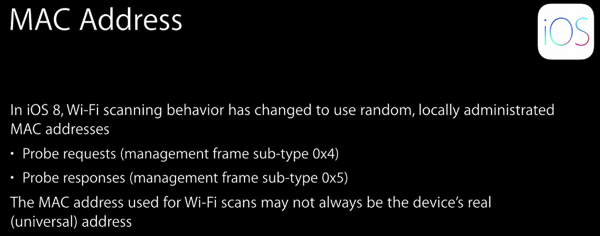A tiny change in iOS 8 prevents WiFi tracking of iOS devices

News just broke of a new feature in iOS 8 announced at Apple’s WWDC which was not covered in the big keynote. Advertisers and retail outlets have been using Wi-Fi to track mobile devices for some time. I talked about a network of Wi-Fi tracking trashcans last year in the podcast.
This works because, by default, most mobile devices are constantly on the lookout for Wi-Fi networks. The device communicates with visible base stations to see if they are known, if they are secure, and what they are called. That communication reveals the MAC address of the device’s Wi-Fi.
Like the address on your house, your phone number, or IP addresses, MAC addresses are globally unique identifiers. Everything that can speak Wi-Fi has its own individual MAC address. This makes it a great hook for tracking. If someone sets up a bunch of Wi-Fi base stations, most mobile devices going by will try to connect, giving it their MAC address. By looking at the pattern of those connections, the device can be tracked.
More sophisticated solutions have even used signal strength to triangulate the location of devices within a small area.
The big news is that Apple is going to randomize the MAC addresses of iOS 8 devices when they are probing for networks. If the device were to probe network base stations A, B, and C they would all see different MAC addresses and think that they were tracking different devices. The iPhone or iPad would still use its real MAC when establishing a full connection, but would not provide it to all of the networks it only probes but never actually uses.
This is a really small change which provides significant privacy gains. It is similar to the decision Apple made to use randomized IPv6 addresses by default, rather than ones which uniquely identify the computer or mobile device.
Of course, Apple is also working hard to track us all with iBeacons at the same time….
Lance Cottrell is the Founder and Chief Scientist of Anonymizer. Follow me on Facebook, Twitter, and Google+.